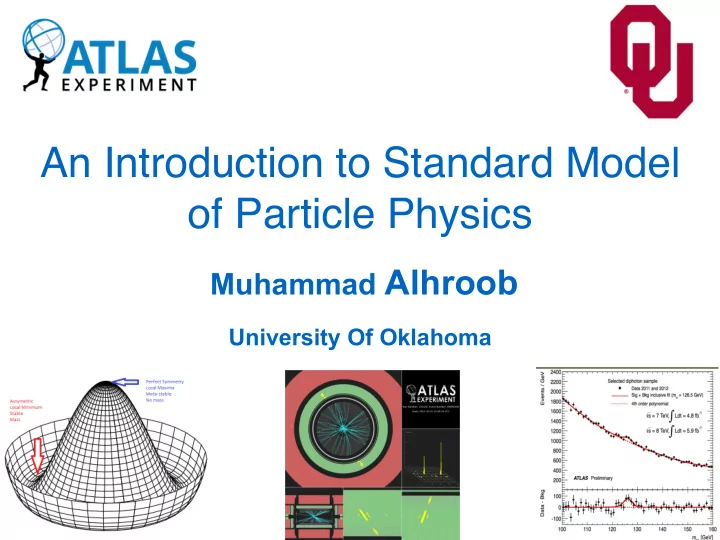

An Introduction to Standard Model of Particle Physics Muhammad Alhroob University Of Oklahoma 1
Elementary Particles Elementary particles cannot be broken down Truly point like particles • Form the basic structure of all matter • Are the force carriers of the fundamental interactions 2
The Universe Started with a Big Bang • The universe started ~13.8 billion years ago with a big bang • It was a super hot universe • Only elementary particles existed • As time evolved the universe expanded and cooled down • Energy converted into matter 3
Ordinary Matter Electron • Protons and neutrons are composite objects, made of: • valence quarks (uud, udd) Proton • gluons • Particles composed of quarks are called hadrons Neutron 4
Inside Hadrons gluons Proton: Neutron: • Up quark(charge +2/3) • Up quark(charge +2/3) • Up quark(charge +2/3) • Down quark(charge -1/3) • Down quark(charge -1/3) • Down quark(charge -1/3) • Quarks have three colours (quantum charges) • What is the electric charge of the Proton? unit? • What is the colour of the proton? 5
Inside Hadrons Proton • Quarks and gluons collide with each other and produce more quarks and gluons • Sea of quark and antiquark pairs • Most of the body mass is pure kinetic energy of the proton constituents! E 2 = M 2 C 4 + P 2 C 2 6
Elementary Particles Force carriers • Spin 1/2 particles called fermions: • Quarks • electric charge 2/3 or -1/3 • three colours • cannot be found isolated in nature, must exist as Hadrons in groups of TWO ( Mesons ) or THREE ( Baryons ) • Leptons : • neutrinos, electrically neutral Ordinary matter • charged leptons , -1 7
Leptons • Neutrinos, electrically neutral • almost massless • Charged leptons, -1 • only electrons are stable, muons and tau-leptons are unstable: Muon ( µ ) lifetime = 2 x 10 -6 s Tau ( τ ) lifetime = 3 x 10 -13 s • much heavier than electrons • muons are produced when cosmic rays hit the atmosphere (15 km above the earth surface, How can muon arrive the earth with the very short lifetime?! 1 muon/sec/cm 2 hit your body 8
Antimatter • For every elementary particle there is an anti particle • Anti particles are exactly the same as particle except the charge • What is the difference between neutrinos and anti neutrinos?! 9
Fundamental Forces Gravity: • the first known force, occurs between all objects that carry energy • long range force related to space and time • responsible for the movements of the planets, stars and galaxies • well described by general relativity (GR) Electromagnetic: • occurs between all objects that carry electric charge (quarks and charged leptons) • responsible for almost all phenomena countered in the daily life: chemistry biology, friction, etc. • long range force and well described by Maxwell’s equations 10
Fundamental Forces Strong force: • occurs between all objects that carry colours ( only quarks ) • very short range force ~ 1 fm • responsible: • holding quarks together inside hadrons • the stability of the nuclei (glues protons together) Weak Force: • occurs between quark and between leptons including neutrinos • very short range force ~ 0.001 fm • responsible: • for radioactive decay (manufacturing new elements) • hydrogen fusion inside stars 11
Force Mediators Force Carrier Mass Charge Spin EM photon 0 0 1 Strong gluon 0 0 1 80.3 and Weak W - ,W + ,Z -1,1,0 1 91.2 GeV These forces are described by a well established theory called the Standard Model theory (SM) 12
Feynman Diagrams • When particles (objects) interact, they exchange other elementary particles EM time Strong Week 13
Higgs Particle • Petter Higgs predicted in 1964 the existence of a particle with spin 0 • This particle plays an important rule in SM • In 2012 this particle was discovered by ATLAS and CMS Collaborations 14
Higgs Particle • Production • Decays within 10 -20 H 15
Fundamental Interactions 16
Beyond the SM • There many things cannot be answered by the SM • how many quarks and leptons in nature? • how many fundamental interactions? • why the electron is extremely light particle compared to the top quark 17
Beyond the SM • Cosmological observations have shown that 96% of the universe is dark! • has gravity effects • cannot interact with light (dark) 18
Beyond the SM • Accelerated expansion of the universe, where does the energy come from?! 19
Beyond the SM • Matter and antimatter asymmetry 20
Recommend
More recommend